I know an old hand who has been in the cryptocurrency world for many years. He entered the market with 100,000 and now his account has jumped to over 15 million. He once said something that enlightened me: the essence of the cryptocurrency world is an emotional playground, where most people are just tourists following the crowd. If you can control your own temperament, this place is a treasure trove.
Following his method, if you want to make real money in the cryptocurrency world, the key is these few points:
Firstly, do not be greedy for small profits, and do not take extreme risks.
This sounds simple, just eight words, but 80% of people will struggle with it for their entire lives. It's like opening a long position at $20,000, and as soon as it rises to $21,000, you panic and take profits, feeling proud of your 5% gain. The market then skyrockets to $25,000, and you miss out on the big gains. Next time, you think you learned your lesson, so when the price returns to $20,000, you open a long position again, and when it reaches $21,000, you stubbornly hold on, desperate to make big money, only for it to drop back to $20,000 or even $19,500, and you end up cutting your losses. Many are trapped in this vicious cycle, unable to break free.
Secondly, specifically choosing mainstream coins that have dropped significantly and are slowly recovering.
Don’t touch those flashy new coins. Start with 10% of your position as a foundation, and don’t guess where the bottom is. Wait until it is stable before making a move. The method may seem clumsy, but it is reliable.
Thirdly, wait for the trend to stabilize and then add 20%-30% of your position on pullbacks.
Others always think about buying at the bottom, but I prefer to wait until the trend is clear, even if the price is higher, it's much better than being stuck in mid-air.
Fourthly, after each rise, first pull back the principal and half of the profits.
Let the remaining positions fluctuate freely; regardless of how crazy the market gets, when it reaches the line you drew for yourself, take action without greed. Money in your pocket is what counts as true profit.
Relying on this practical method, last year he helped a friend who had previously lost more than 600,000 in operations. Within six months, not only did he recover the loss, but he also earned enough for a family car.
This is not just empty talk; there are many smart people in the cryptocurrency world, but what is lacking is the 'real people' who can control their hands and stay calm. While everyone else is chasing highs and lows, if you quietly follow the trend, you may pick up the chips that others frantically abandon.
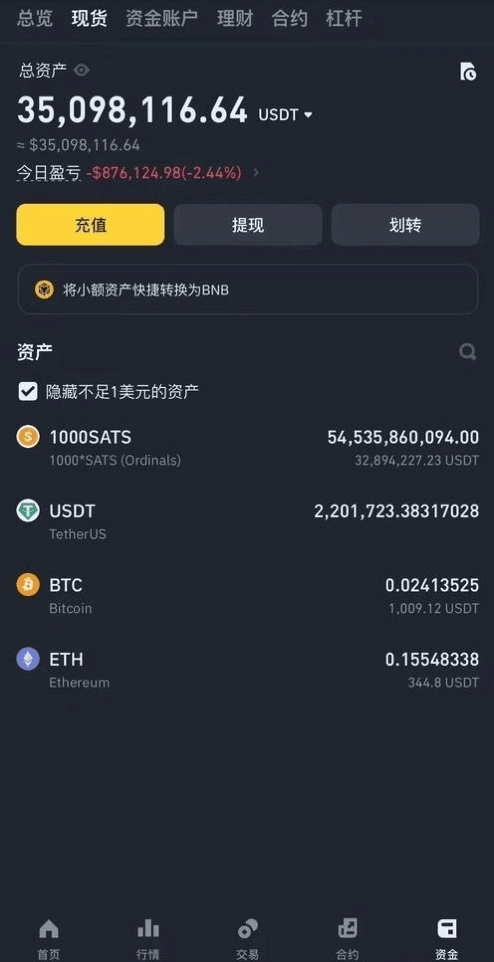
The cryptocurrency contract 'life and death challenge': technical pressure on individual contracts, leverage control techniques exposed!
In the high-tech game of cryptocurrency contracts, there's a fundamental yet easily overlooked technical guideline that I fully understood only after numerous cycles of liquidation and recovery: the all-in model is a 'black hole' for technical trading, swallowing all risk management strategies; the individual contract model is the winning formula for technical traders who proceed steadily and cautiously!
Why am I so sure? From the underlying logic of technical risk management, the individual contract model provides traders with the ability to finely adjust margins and liquidation prices dynamically, like installing a smart risk management engine in the trading system. Even with 10x leverage, under the individual contract model, the calculation model for liquidation prices is more transparent and quantifiable. Traders can strategically adjust positions in batches based on key price levels derived from technical analysis, avoiding total collapse due to misjudgment of a single price level, which is crucial in technical trading.
Next, I will analyze in-depth from a technical perspective based on my personal experience and practical case studies:
Assuming a certain coin's current price is 100U, we use technical analysis tools, combined with historical volatility and market sentiment, to quantitatively assess the risk-reward ratio under different leverage multiples:
10x leverage: From a technical risk management perspective, the liquidation price fluctuates within a range of around 10U above and below 100U. This means that within this price fluctuation range, any sudden technical pullback or unusual movements from major funds could trigger liquidation. At this time, without a flexible adjustment mechanism of the individual contract model, once the price touches the liquidation price, the funds will instantly drop to zero.
20x leverage: After significantly increasing the leverage, technical risks grow exponentially. The liquidation price narrows sharply to a range of 5U above and below, which places extremely high demands on traders' technical analysis capabilities. Any slight deviation in technical indicators or market noise can lead to liquidation. In practice, such high leverage often accompanies short-term high-frequency trading strategies, but without the protection of the individual contract model, frequent trading and extremely narrow liquidation ranges will expose funds to very high risks.
2x leverage: In contrast, the strong liquidation price under 2x leverage is in a wide range of 50U above and below. Analyzing from the perspective of technical trading, this provides traders with ample technical adjustment space. Even if the market experiences significant short-term volatility, traders have enough time to flexibly adjust their positions and margins based on changes in technical indicators, avoiding forced liquidation.
In fact, spot trading is essentially a 1x leverage contract trading; when the price drops to zero, resulting in a loss of 100U, this has a similar effect to a 1x leverage liquidation in contract trading in terms of technical risk.
The choice of leverage is not fixed; it requires the use of technical analysis tools, combined with the dynamic changes in market conditions for flexible adjustments. In short-term intraday trading, due to the shorter time period, market fluctuations are relatively centralized. We can refer to the recent highest and lowest price differences, using volatility indicators and other technical tools to reasonably calculate the leverage ratio. If the market can fluctuate by thousands of points, setting reasonable leverage through precise technical analysis can maintain a safe distance between the liquidation price and the current price, providing sufficient technical buffer space for trading.
For medium- to long-term trading, due to the longer time span, the uncertainty factors in the market increase, and market fluctuations become more complex and difficult to predict. From a technical risk management perspective, the leverage ratio should be lowered at this time, leaving more room for technical adjustments and financial buffer space to cope with potential technical reversals and unexpected market events.
The technical characteristics and market performance of different cryptocurrencies vary greatly, and the choice of leverage should also differ based on individual circumstances and specific coins. For example, in the case of popular coins, the 24-hour volatility can reach as high as 30%. If stubbornly using a high leverage of 20x at this time, from a technical risk assessment perspective, liquidation is almost inevitable. Many newcomers often overlook this and blindly pursue the high returns brought by high leverage, ignoring the huge technical risks hidden behind, ultimately leading to total loss—this is a painful lesson I have experienced.
Trading cryptocurrencies means repeatedly doing simple things, consistently using one method over a long period until you master it. Trading can be like other industries, where practice makes perfect, allowing you to make every decision automatically without overthinking.

These 6 practical iron rules, understanding one can help you lose less than a house in a bear market;
If you can achieve three of these points, you can already shake off 95% of the retail investors.
First Rule: The longer a sideways market lasts, the more explosive the breakout, but keep a close eye on the 'breakthrough point'.
Don’t think that a sideways market is stagnant; it's a battle of strengths between bulls and bears. Coins that have been sideways for over 30 days, once they break above the upper boundary with volume, often have more than 30% space to rise; but if they break below the lower boundary without volume, run quickly—that's the main force secretly dumping.
Second Rule: A sharp rise with a long upper shadow is not an opportunity but a trap.
A large bullish line suddenly shoots up, but the tail is very long; this is not about taking off; it's the main force dumping goods from a high point. This kind of 'shooting star' appearing more than three times, regardless of how much it jumps afterward, is all a trap to lure people in, and going in means you are just taking the leftovers.
Third Rule: The 'Red Three Soldiers' during a downtrend are mostly a recovery of previous losses.
Three consecutive small bullish lines may seem like a rebound? Don’t be foolish; in a bear market, this is mostly the main force doing a 'false rebound' to trick you into picking up chips. The real bottom must be 'green bars shortening + shrinking doji'; that indicates a true signal of being deeply oversold.
Fourth Rule: A sudden increase in trading volume by more than 10 times, regardless of whether the price rises or falls, should be treated with caution.
On days when the average daily trading volume is several million, if it suddenly spikes to several hundred million, this is not the arrival of a new trend; it's the main force 'trading against itself'. It could either be trying to push the price up to sell or creating panic to accumulate; during such times, observe more and act less, and wait until it finishes its turmoil.
Fifth Rule: Trading cryptocurrencies is not about guessing price movements; it's about calculating the 'profit-loss ratio'.
Don't always think about buying at the lowest and selling at the highest; that's something only a deity can do. Before placing an order, calculate clearly: if you are wrong, how much will you lose at most? If you are right, how much can you earn? If this ratio is less than 3:1, it’s better not to trade. Over time, you will find that losing less is earning.
Sixth Rule: 'Waiting' is the highest level in the cryptocurrency world.
Wait until the trend is clear to act, wait for the signal to confirm before entering, and be greedy when others are panicking. 90% of losses stem from 'inability to resist'; it's not that opportunities are scarce, it's that you are too impatient. Those who can control their hands have already made a fortune.
The cryptocurrency world has never lacked stories of getting rich quickly, but those who survive are the ones who understand the rhythm. It's not that you are unlucky; it's that you are always doing the wrong thing at the wrong time.
Getting started in the cryptocurrency world: Master these 24 K-line patterns!
From a classification perspective, there are a total of 48 types of K-line patterns, with bullish lines accounting for 24 types and bearish lines for 24 types. The two are similar in form, differing only as one is bullish and the other is bearish.
The bullish line is mainly divided into small bullish lines, medium bullish lines, large bullish lines, and bullish doji.
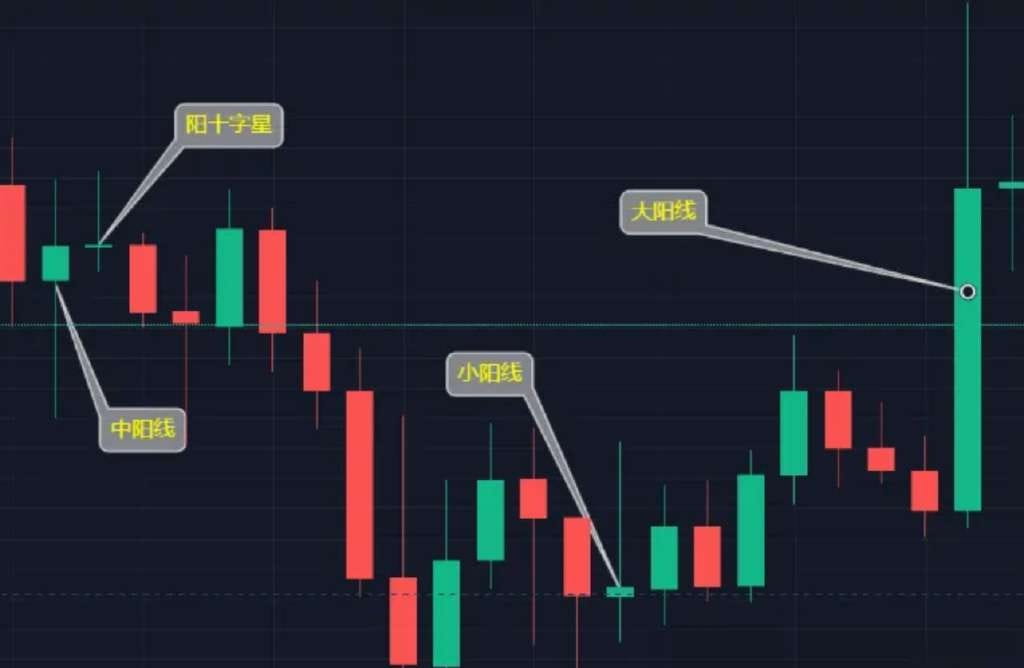
The volatility range of a small bullish line is generally between 0.6% and 1.5%.
The volatility range of a medium bullish line is generally between 1.6% and 3.5%.
The volatility range of a large bullish line is above 3.6%.
1. Bullish doji
Market turning point of bullish balance.
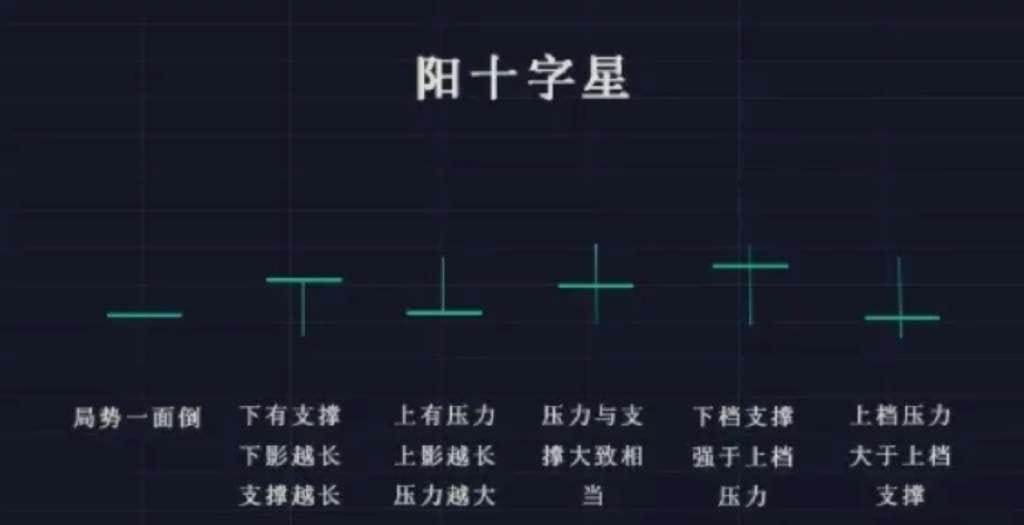
The volatility is very small, with the opening price and closing price being extremely close, and the closing price slightly higher than the opening price. The appearance of a bullish doji indicates that the market is in a chaotic and unclear phase, and future price movements are unpredictable. At this point, one must comprehensively judge based on the shape of the previous K-line combinations and the price region at that time.
2. Small bullish line
The proactive bullish trend is relatively soft.
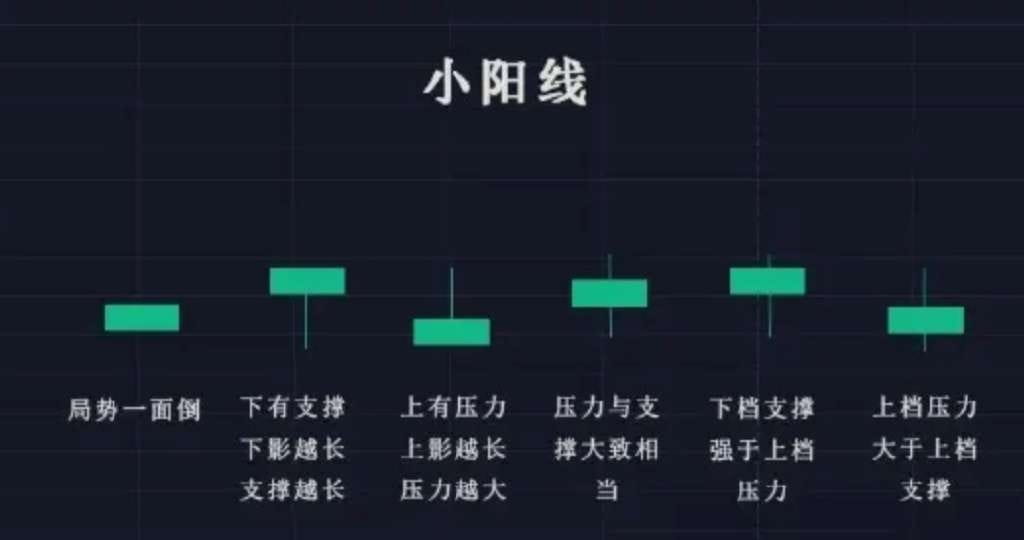
The volatility range is larger than that of a bullish doji; bulls have a slight upper hand, but the upward momentum is weak, indicating that market development is confusing.
3. Medium bullish line
The bullish forces are strong.
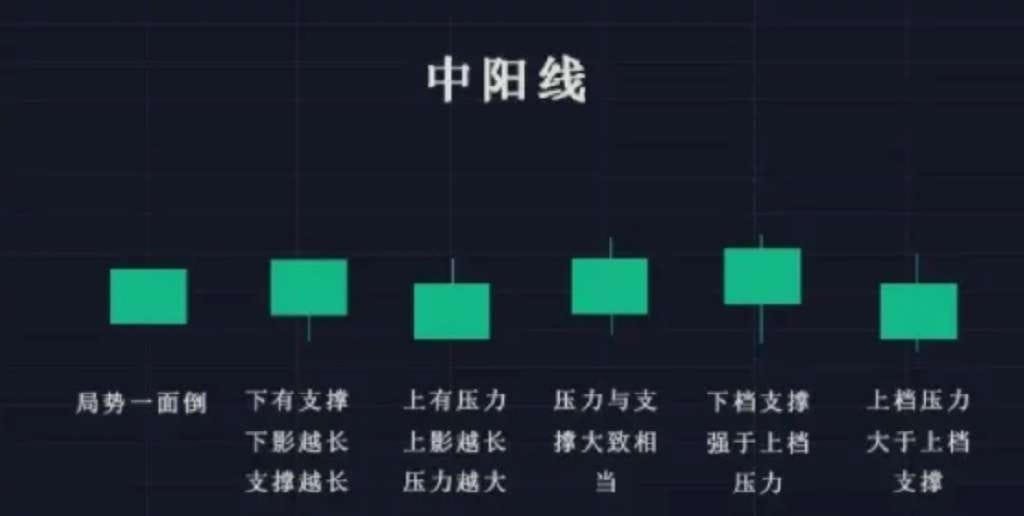
The buying power is greater than the selling power, giving buyers an advantage, and the price ultimately rises at closing.
4. Large bullish line
Bulls hold absolute advantage.
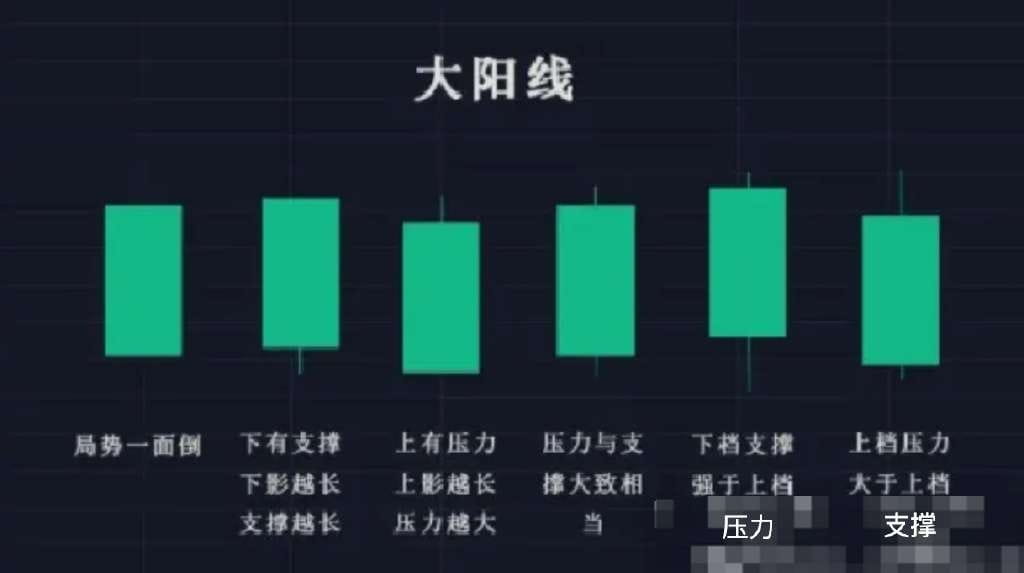
From the moment the market opens, buyers actively attack; there may be struggles between buyers and sellers in between, but buyers exert maximum strength until closing. Buyers remain dominant, driving the price up until the close.
The larger the body of a bullish line indicates stronger buying pressure, which generally leads to a rise. A longer lower shadow indicates stronger buying pressure, usually leading to a rise; a longer upper shadow indicates stronger selling pressure, generally leading to a decline.
Bearish lines are mainly divided into large bearish lines, medium bearish lines, small bearish lines, and bearish doji.
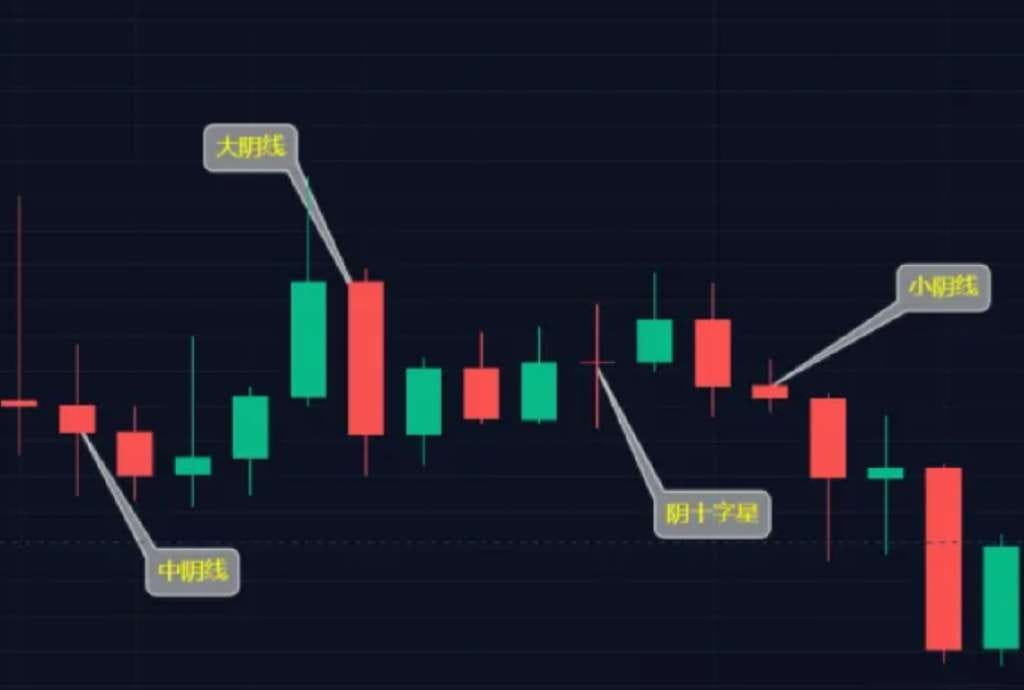
1. Bearish doji
Market turning point of balance between bulls and bears.
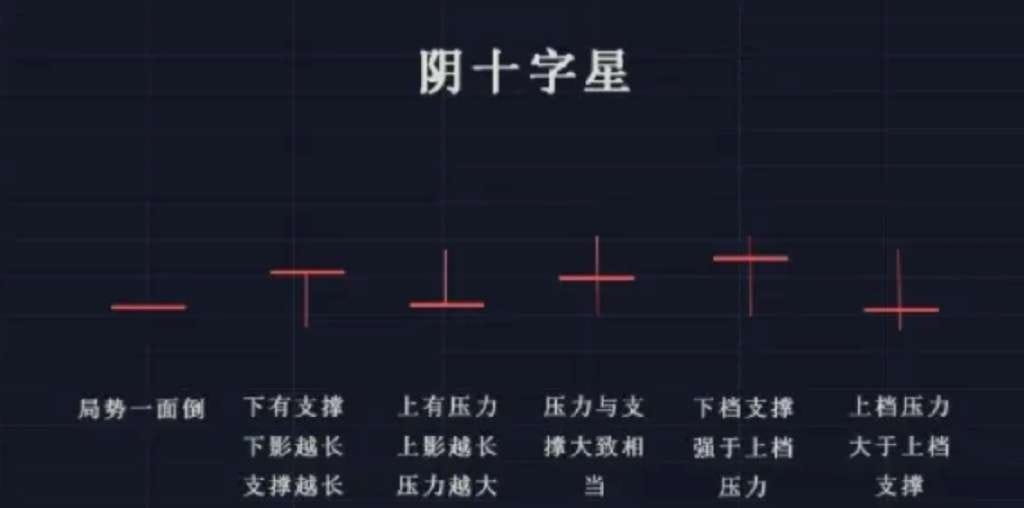
The minute chart of a bearish doji is similar to that of a bullish doji, except that the closing price is slightly lower than the opening price. This indicates a weak market with an unclear direction.
2. Small bearish line
The bearish trend is relatively soft.
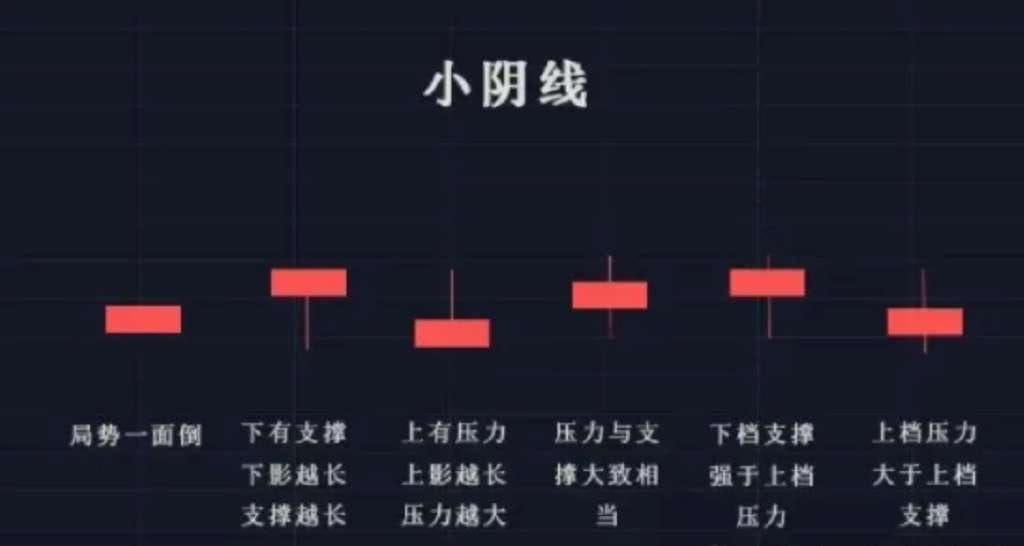
The bears show a suppressive trend, but the strength isn't significant.
3. Medium bearish line
Bearish forces are strong.
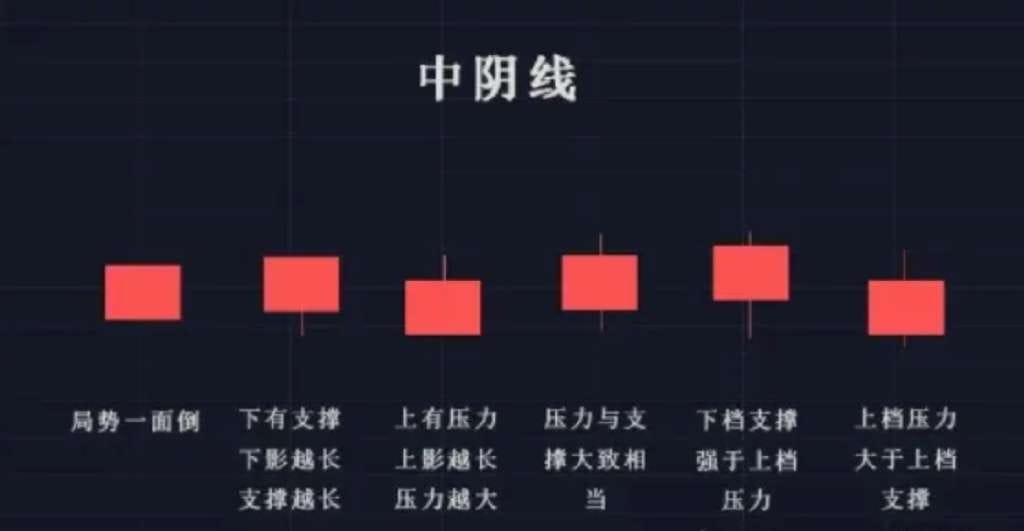
Selling power is greater than buying power, giving the sellers an advantage, and the price ultimately falls at closing.
4. Large bearish line
Bears hold absolute advantage.
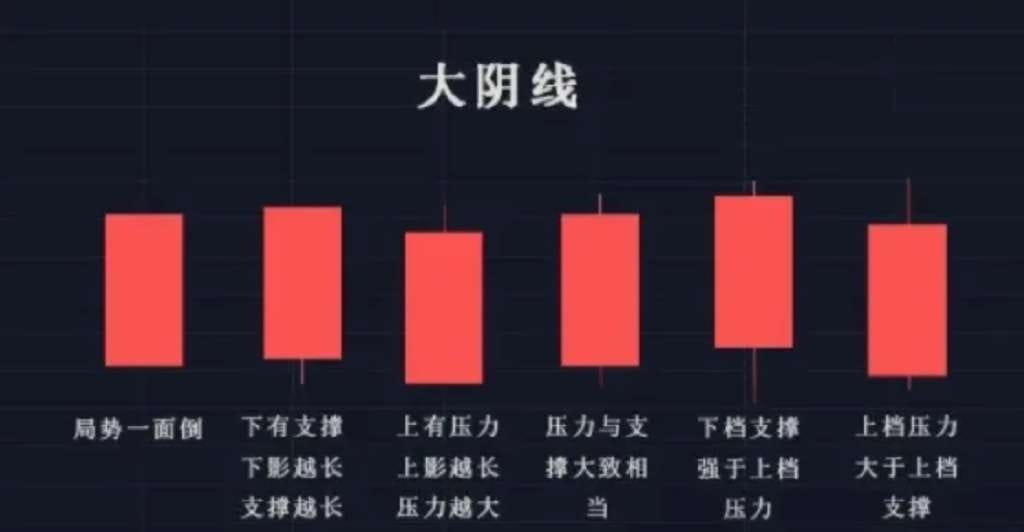
During the trading process, as selling power increases, buyers are unwilling to chase high prices, and sellers gradually take the initiative, causing the currency price to reverse, trading below the opening price and leading to a price drop.
The larger the body of a bearish line, the stronger the selling pressure, which generally indicates a decline in the market. A longer lower shadow indicates stronger buying pressure, usually leading to a rise; a longer upper shadow indicates stronger selling pressure, generally leading to a decline.
I have been in this circle for ten years and have seen too many instances of instant zero and too many people slowly becoming rich through simple methods. How many people in the cryptocurrency world have really made money?
Many people disdainfully say that those who have experienced several cycles in the cryptocurrency world and made a lot of money are gamblers or just lucky. Here's the truth: don’t be jealous; those who have obtained significant wealth in the cryptocurrency world and held onto it are not lucky; don't be unconvinced.
I won't talk about the many pitfalls of ancient times, as they were certainly more thrilling than now. Just look at now; those who made a lot of money and held onto it surely avoided all of the following:
1. Open contracts.
2. Bought a large amount of non-Bitcoin.
3. Putting all coins on exchanges.
4. High-frequency trading, attempting to buy high and sell low.
Don’t underestimate these 4 points. If you don't pay deep attention to the cryptocurrency world, you won't understand. And those who can make big money in the cryptocurrency world must have paid deep attention and have traded continuously—these people can maintain the four principles above after making big money, indicating they must have suffered significant losses on these issues, and after completing their cognitive training.
And you can still accumulate large funds in the cryptocurrency world without using the gambling methods mentioned above; isn't that luck?
Most people in the cryptocurrency world are merely 'once made money' because their paths to making money only involve the above points, which naturally leads to losses due to those same points. When a person realizes that the above points cannot truly lead to wealth but can't find other methods to get rich in the cryptocurrency world, that’s where the problem lies.
Let me tell you, those who really made money in the cryptocurrency world and kept it long-term, aside from avoiding the above pitfalls, must meet at least one of the following conditions:
1. Have a flagship product in the cryptocurrency world.
No matter how much you know, you will still step on the same pits mentioned above and lose the coins you should have. But the key point is, you have a product that continuously makes money in the cryptocurrency world, which helps you recover the coins you've lost, no matter how many pits you step on. As you become smarter, you stop stepping on those pits, and thus your coins increase—representative figures like CZ and Sun have all stepped on these rookie pits, but the key is that they have products to help them continuously earn back coins, while you don’t, and that is the crux.
2. Ability to maintain continuous dollar-cost averaging.
If you lack the ability to create a product, then the easiest thing for you to match is this: stop saying 'Bitcoin won't rise much more'; that's not a reason to gamble with large positions—when has Bitcoin ever moved quickly? Bitcoin was low back then, but that's compared to now. The Bitcoin of that time and the altcoins of that time both rose more slowly, but where are those altcoins now? Give yourself 10 years, gradually invest the money you earn over the next 10 years, allowing your wealth to multiply by 5 or 10—this is the best way for ordinary people to enter the cryptocurrency world.
The premise here is to have a good locking mechanism where you can only enter but not exit; a good dollar-cost averaging environment where you don't invest just because you have money today or skip investing when you don't; and also an excellent off-exchange funding capability— the stronger your ability to make money, the more these rules will benefit you.
All the above premises are indispensable. A person who can possess the ability to turn things around off-market while being humble and obedient in the market is inherently remarkable; this money is what you deserve.
3. Coins are locked up.
I participated in an old fund where coins were locked for 5 years. During that time, the cryptocurrency world experienced many ups and downs, but the money was locked, and I couldn't touch it. Were there times when I needed money in reality? Of course. During this period, I also bought a house and had to turn to banks for short-term loans when investment returns hadn’t come back yet. Later, the coins I had in my hands dwindled as I navigated the ups and downs of investing and entrepreneurship, but when this fund finally distributed profits, I found that my shares had accumulated several hundred bitcoins—although the fund still didn't outperform using the money to hoard coins directly, the point was that it was indeed locked, and the percentage loss of coins in the fund was far less than what I held myself.
In the cryptocurrency world, such things are common; a certain loser bought coins, went to jail for hitting someone, and came out with over 100 million—this is not a story, it's reality. If he hadn't gone to jail, he would have long since wasted those coins.
Since then, I actively locked away the largest share of Bitcoin, and I've kept it locked until now. If you believe in Bitcoin, now is the time to convert all your assets into Bitcoin, actively lock it away for 10 years, and then start from scratch. After 10 years, the result will likely exceed everything else you did in those 10 years that seemed more useful.
Once again, I have never seen a big shot become a big shot through trading cryptocurrencies—not one—trading cryptocurrencies cannot make you a big shot, and leverage cannot make you a big shot. There is no such thing as luck in the cryptocurrency world. Your understanding must be in place first; only then can it become your best tool for wealth accumulation, otherwise, you will become its slave.
After more than 10 years of trading cryptocurrencies and experiencing 4 bull and bear cycles, I can say that to truly preserve wealth, be a steadfast believer in Bitcoin, and accumulate Bitcoin, wealth will naturally come to you!
